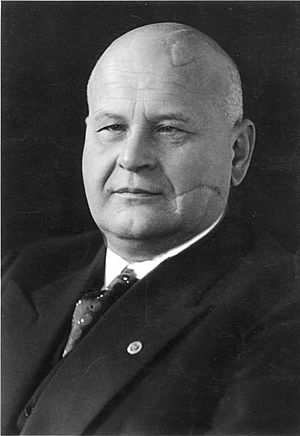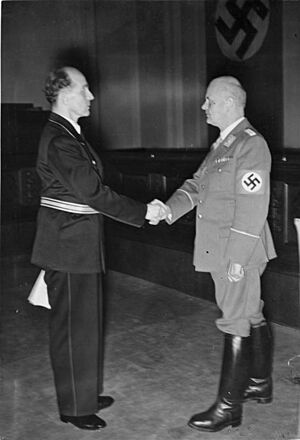Otto Georg Thierack facts for kids
Quick facts for kids
Otto Georg Thierack
|
|
|---|---|
 |
|
| Minister of Justice | |
| In office 24 August 1942 – 5 May 1945 |
|
| Chancellor | Adolf Hitler |
| Preceded by | Franz Schlegelberger |
| Succeeded by | Herbert Klemm |
| President of the Academy for German Law | |
| In office 20 August 1942 – 8 May 1945 |
|
| Preceded by | Hans Frank |
| Succeeded by | Office abolished |
| Judge President of the People's Court | |
| In office 1 May 1936 – 20 August 1942 |
|
| Preceded by | Wilhelm Bruner |
| Succeeded by | Roland Freisler |
| Personal details | |
| Born | 19 April 1889 Wurzen, Kingdom of Saxony, German Empire |
| Died | 26 October 1946 (aged 57) Sennelager, North Rhine-Westphalia, Allied-occupied Germany |
| Nationality | German |
| Political party | Nazi Party |
Otto Georg Thierack (born April 19, 1889 – died October 26, 1946) was a German jurist and politician during the Nazi era.
Contents
Early Life and Career
Thierack was born in Wurzen, a town in Saxony. He joined the First World War as a volunteer from 1914 to 1918. He became a lieutenant and was awarded the Iron Cross, second class, for his service. After the war, he finished his law studies. In 1920, he passed his final law exam and began working as a junior lawyer in Saxony.
Joining the Nazi Party
On August 1, 1932, Thierack became a member of the Nazi Party. After the Nazis took control of Germany in 1933, he quickly rose through the ranks. He went from being a prosecutor to becoming the President of the People's Court. His quick rise was not just because he was a Nazi Party member. He also led the National Socialist jurists' organization, known as the Rechtswahrerbund. This group was for lawyers who supported the Nazi ideas.
Justice Minister of Saxony
On May 12, 1933, Thierack was made the justice minister for Saxony. His job was to make the justice system follow Nazi rules. This was part of the Nazis' plan called Gleichschaltung, which meant making everything in society fit their ideas.
After holding several other legal positions, he became the Vice President of the Reich Court in 1935. In May 1936, he became the President of the Volksgerichtshof, or People's Court. This court had been created in 1934. He held this important job until August 1942. During this time, he also served two short periods in the armed forces. Roland Freisler took over his role at the People's Court. On August 20, 1942, Thierack also became the President of the Academy for German Law, taking over from Hans Frank.
Reich Minister of Justice

On August 24, 1942, Thierack became the Reich Minister of Justice for all of Germany. He introduced new ways to control how courts made decisions. In October 1942, he started the monthly Richterbriefe (Judge's Letters). These letters showed examples of court decisions that the Nazi leaders wanted judges to follow.
He also started "previews" (Vorschauen) and "inspections" (Nachschauen). This meant that senior court presidents had to discuss important cases with prosecutors and other court officials. They would talk about how a case should be decided before the court made its final ruling.
When he became Justice Minister, Thierack also changed the process for people sentenced to death. He made it much quicker for these cases to be reviewed. In September 1942, he ordered that certain groups of people in custody, such as Jews, Roma, Ukrainians, and Poles, be transferred to the control of Heinrich Himmler and the SS. These groups were labeled as "asocial elements."
Thierack was named to continue as Minister of Justice in Hitler's final political plans. He served briefly in the government led by Joseph Goebbels. However, he was removed from his position on May 5, 1945, by Karl Dönitz, who took over after Hitler.
Images for kids
See also
 In Spanish: Otto Georg Thierack para niños
In Spanish: Otto Georg Thierack para niños


